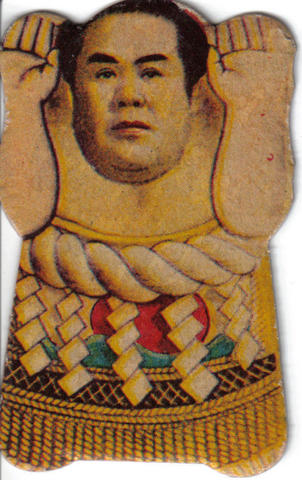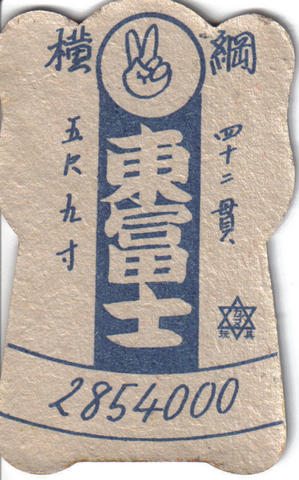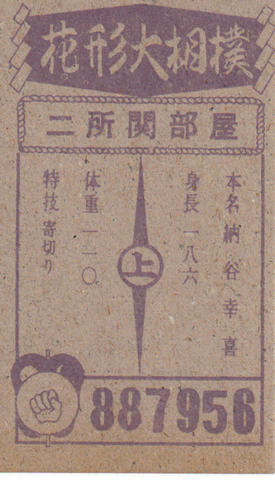|


|
SOS - Shinjinrui on Sumo |


|
Chris Gould
Wrapping up his look at increasing the popularity of sumo, Chris Gould caps a series the NSK would do well to refer to.
|
|
|
Sumo Souvenirs |


|
Mark Buckton
Souvenirs are a part of every sport and sumo is no different - or is
it? A look at collectibles and the downright trashy, the bona fide
versus the unproven.
|
|
|
Rikishi of Old |


|
Joe Kuroda
Joe Kuroda's latest look at times past focuses on former makunouchi man Dewagatake.
|
|
|
Eric Evaluates |


|
Eric Blair
Eric takes a no-nonsense look at the claims of fixed bouts in the Japanese media.
|
|
|
Rikishi Diary |


|
Mark Kent
Mark Kent - English pro-wrestler and amateur heavyweight sumotori -
takes us through the first month or so of his training and preparation
for the various European events lined up in in 2007.
|
|
|
Heya Peek |


|
Chris Gould
SFM's Chris Gould was in Japan for the Hatsu Basho and popped along to
the new Shikoroyama Beya to give SFM an online exclusive peek into
sumo's newest heya.
|
|
|
SFM Interview |


|
Mark Buckton
Mark interviews Mark - Buckton on Kent that is as Mark Kent, the UK's
only active heavyweight amateur answers a few questions on his own
recent entry into the sport.
|
|
|
Photo Bonanzas |


|
Sumo Forum stepped in to take the weight off the shoulders of SFM as
far as Hatsu went so we could sit back, relax, enjoy the sumo and take
a few more select pics you won't see anywhere else.
|
|
|
Hatsu Basho Summary |



|
Lon Howard
Lon wraps the Hatsu Basho and chucks in a few bits on the rush of henka
that threatens to sully the good name of at least one foreign ozeki.
|
|
|
Sumo Menko |


|
Ryan Laughton
Sumo cards of old brought to life by expert collector Ryan Laughton. None of your BBM here.
|
|
|
Haru Ones To Watch |



|
Carolyn Todd
Carolyn ponders and puts fingers to keys on the ones to watch come March and the Haru Basho.
|
|
|
Kimarite Focus |


|
Mikko Mattila
Mikko's latest look at sumo's kimarite offers unequalled analysis and in depth explanations.
|
|
|
Amateur Angles |


|
Howard Gilbert
Howard looks at the 'sumo factory' of lore - Nichidai.
|
|
|
Kokugi Konnections |



|
Todd Lambert
Click on Todd's bimonthly focus on three of the best the WWW has to offer.
|
|
|
Fan Debate |


|
Facilitator - Carolyn Todd
Moti Dichne comes back for more and takes on Bradley Sutton on the subject of 'Modernize the heya - yea or nay?'
|
|
|
SFM Cartoons |
|
Benny Loh & Stephen Thompson
In this issue's cartoon bonanza, sit back and sample Benny's artistic offerings.
|
|
|
Sumo Odds & Ends |
|
SFM's interactive elements - as always includes Henka Sightings, Elevator Rikishi and Eternal Banzuke!
|
|
|
Let's Hear From You |



|
What was it that made you a sumo fan? Ryan Laughton - sumo fan and menko expert reveals all.
|
|
|
Readers' Letters |


|
See what our readers had to say since we last hit your screens.
|
|
|
Sumo Quiz |
|
The Quizmaster
Answer the Qs and win yourself a genuine banzuke.
|
|
|
 |
|
Die-cut Menko Example: 1953 Kagome Rikishi 7 Set - Yokozuna Azumafuji
Sumo menko really didn’t emerge until the early 1940s. Before
that, most sumo menko were actually stadium card sets sold at
tournaments. These were simple cards showing almost all the top
division rikishi in their kesho-mawashi, with a blank back. They
were not used in any menko games. The menko paper was extremely
thin and they were really meant as a collectible. Actual pre-war
menko are extremely hard to find as Japan had wartime paper drives and
many children turned in the few menko they had to support the war
effort.

The years between the mid 1940s and the mid 1960s were really the
golden years of sumo menko. The economic shift after WWII meant
that kids had more money to spend on menko, and more and more sets were
being produced by various toy companies. Kagome and Yamakatsu
were the big companies of the time; and no less than 10 toy
companies were in the menko printing business; I myself have come
across more than 100 different sets produced during this 20-year period
and there are many more out there. The emergence of popular
rikisihi such as Tochinishiki and Wakanohana I (future yokozuna),
created a huge sumo boom which started in about 1954.
Between
1954 and the early 1960s, during the Tochi-Waka era as it’s called, is
when you can find the most sets, and thus, the most cards produced.
|

|

|

|
Naturally, the majority of sumo menko that survive
today are from this timeframe. Another couple of reasons
exist(ed) to explain this boom in menko numbers including the fact that
prior to the mid-1950s, menko were made and used for ‘battle’.
Printing and production quality was generally poor and kids would
destroy their menko in battle with little thought given to keeping the
pieces as a collection or for simply appreciating the cards for their
aesthetic value.

Toward the mid 1950s, however, the quality of printing went up and many
kids actually opted to collect the menko instead of using them to play
out battles. This trend continued through the mid 1960s when
Japan fell on relatively hard economic times. Many kids then
started to devote more time to their studies, in order to get ahead in
life, and the role of menko diminished. Coupled with Japan’s
emergence as an economic world power and industry becoming more
technologically advanced, one of many victims was menko; television and
other modern forms of entertainment serving to replace these links to
the past. To highlight this fact, I’ve never run across a single sumo menko dated after 1965!
One of the last sumo menko sets produced: 1962 Gohei 6 - Yokozuna Taiho
Now that we’ve talked about the history of sumo menko, let’s talk
|

|

|

|
about the
game that was played by millions of Japanese boys, and sometimes
girls. It is in fact quite simple and involves, for ease of
writing, two ‘players’ with both placing their chosen menko on the
ground and trying to flip the opponent’s menko by slamming it with a
heavier or “slammer” menko.
If you flip one of your foe’s cards
you get to claim it and if he flips yours – the same applies.
It’s actually a similar concept to the game of marbles and almost
exactly like the POG craze in recent times. There are a couple of
variations of menko rules that were also equally as popular and less
vicious. "Gu-choki-pa” marks on the back of the menko are played
as rock-scissors-paper. Kids took out one of their menko to
compare with their opponent's simultaneously following a given
signal. If they won, they take home the opposing menko.
Playing with "Fighting Numbers" is largely the same; trying to
outnumber your opponent's menko on certain digits. For example,
one player might have a Fighting Number of 58786 on his particular
menko and the other might have 777596587 on his. If they were
dueling with the last digit, then the boy with the 7 as his last digit
would win and again get the other boy’s menko. There were many
more ways to play with Fighting Numbers, but this is one example.

I hope this has helped get some of the basics down and to form a
foundation for what we will discuss in the upcoming months. Next
time we’ll talk about how to start collecting sumo menko and some of
the features on a typical sumo menko. Until then……….
|
|











